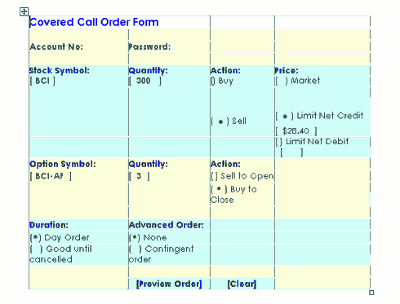Alan Ellman of The Blue Collar Investor outlines two ways to use a buy-write strategy to enter and exit a covered call position.
There are two ways to enter a covered call position. The first is called "legging in," where the stock is purchased and then the option is sold. Two distinct trades are executed. The second is known as a "buy-write order," where the security purchase and option sale is entered as one trade with a net debit limit order.
Buy-Write Order
Buy-Write (Net Debit) Order: Some brokerages (OptionsXpress.com, for example) have set up a special combination order type to allow all elements of a covered call trade to be entered at one time. This order type is called a buy-write, or net debit order.
With this order type, we enter a limit order (execution at a specific price or better is specified) in the form of a net debit. Net debit simply means that we owe the brokerage money, or we pay them.
For example, if we buy a stock for $20 and sell the call option for $1, the net debit is $19, excluding commissions. Since the order is specified as a limit order, we pay $19 per share (or less/better) for the order to be executed. The commission for this trade may be slightly less than the cumulative commission charged for each of the two executions warranted to affect a trade by legging in.
Opening a Covered Call Position Using a Buy-Write
Let's look at an example of such a buy-write order (see figure below). In this hypothetical, we will purchase 300 shares of Blue Collar Investor Corp. (BCI) and sell the next month's call option. Here are the current statistics for this hypothetical example:
- Current (ask) price for BCI Corp. is $28.20
- Current (bid) price for BCI January $30 call is $0.70
- Net debit is $27.50
Achieving a more favorable fill (execution) for your order can be accomplished when using this combination order type by slightly lowering your limit net-debit order. Thus, in the example detailed above, you may use $27.45 or $27.40, depending on the spread of the option bid-ask price. The larger the bid-ask spread of the option, the better the chance of getting a more favorable fill.
Let's look at the entries on this combination form to open a covered call position:
- Buy 300 shares of BCI
- Sell to open three contracts of the January $30 call option
- Limit net-debit order for $27.50 (or less, if playing the bid-ask spread, described in further detail below)
Select Day Order: This order is good for the day only, as opposed to "good until cancelled" order, which stays active until specifically cancelled by the investor. A day order is the best duration for covered call writers. If our order is not filled the day it is placed, we can re-evaluate the trade returns the following day, as implied volatility may change. This then could impact the option premium and our calculations will to be re-evaluated. (Do not select advanced orders; those are not dependent on any other event.)
Preview: Check to make sure the order is correct, and if so, place the order.
NEXT: Closing a Covered Call Using a Buy-Write Order
|pagebreak|Closing a Covered Call Position Using a Buy-Write Combination Order
Next, let's turn our attention to the chart below to see how we can use a combination order type to close our covered positions. For purposes of this chart, assume the following: Two weeks later, BCI is trading at $28.50 per share (bid).
- BCI Jan. $30 is trading @ $0.10 (ask)
- Net credit is $28.40
Let's look at the entries detailed on the above chart wherein we use this combination order form to close our covered call position:
- Sell 300 shares of BCI
- Buy to close (buy back) the three January $30 call option contracts
- Limit net-credit order for $28.40 (or more, if playing the bid-ask spread)
- Select Day Order
- Preview: Check to make sure the order is correct, and if so, place the order
Mathematics of closing the position:
- Net credit net debit = Net Profit ($28.40 - $27.50 = $0.90)
- Percentage return = Net Profit/Cost basis = $.90/$27.50 = 3.3%
Conclusion
Legging in and buy-write combination orders are the two order types by which a covered call position can be established when the underlying equity is not yet owned. Buy-write order types are particularly useful when you can't get to your computer to affect trades on a regular basis. Bear in mind, however, that not all online brokerage firms offer the buy-write order type.
By Alan Ellman of The Blue Collar Investor






















